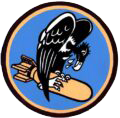Much like the handmade bullion SSIs and personalized flight jackets from the last article helped the airmen showcase what group they belonged to, aircraft were no different. As the bomb groups of the 15th AF began to arrive overseas and conduct combat missions, aircraft markings evolved to ensure units could easily identify their own ships among the massive air armadas. In addition to group identifiers, personalization by the airmen was not limited to uniforms and jackets, as shown by the wide range of nose arts affectionately adorned to the aircraft by their crews.
Tail Markings
When the B-24Hs of the 455th arrived in Italy following their long journey from the states in January 1944, the only markings on those giant tails were the yellow factory serial numbers. As the crews began flying their first combat missions in February, after the first few missions the first group markings were applied in the form of a simple “2” painted on the bottom of the rudder. These were initially done in what appeared to be the same color as the bars to the national insignia, i.e. off-white or a light shade of grey-blue (and possibly black). The “2” identified the 455th as the second group in the 304th Wing, the first being the 454th BG, the third being the 456th BG, and the fourth being the 459th BG.
(743rd) B-24H 42-52253 “SNUFFY SMITH AND THE YARD BIRDS”
In order to further aid in the group’s overall identity, the markings were expanded to include a hollow blue/black diamond in a white circle on the top of the rudder to represent the 304th Bomb Wing. In addition a white circle background was added behind the “2”, which was then also painted in blue/black like that of the hollow diamond. This style of tail marking was seen from approximately mid March to to mid May.
(742nd) B-24H 41-28640 “RAUNCHY”
(742nd) B-24H 42-52259 “TWIN TAILS”
By late April to early May of 1944 the 15th AF had refined and standardized tail markings across the board by giving each group their own color and shape. For the 455th, this consisted of painting the bottom of the rudders yellow, paired with a solid white diamond near the top (and oftentimes split to accommodate the ship’s serial number location which varied). In addition, the 455th added markings (in white) to help identify which squadron a ship belonged to:
740th: Vertical Bar
741st: Shamrock
742nd: Horizontal Bar
743rd: Diagonal Bar
These markings would be carried for the remainder of the 455th’s time in Italy, with the only “modification” to the tail markings being the change of color from white to black on the diamond and squadron identifiers when natural metal finish aircraft began joining the group.
(740th) B-24J 42-99748
(741st) B-24G 42-78359 “TEN HITS AND A MISS”
(742nd) B-24G 42-78360 “FUBAR II”
(743rd) B-24H 41-29583 “TEPEE TIME GAL”
Radio Call Numbers
In addition to the squadron identifiers, an aircraft’s squadron assignment could also be determined based on what batch of numbers the ship’s assigned Radio Call Number (RC#) fell in. RC#s (often referenced as RCLs – Radio Call Letters, due to other groups’ use of letters in place of numbers) were issued to allow aircraft to be quickly identified during communications. These numbers began to appear around April/May ‘44 and were painted behind the waist gun positions (white for OD aircraft and black for NM aircraft).
740th: 1-20
741st: 21-40
742nd: 41-60
743rd: 61-80
(740th) B-24H 42-64234 “GHOST OF A CHANCE” with RC# 15
(741st) B-24J 44-41199 “YO-YO” with RC# 31
(742nd) B-24J 44-41151 with RC# 51
(743rd) B-24J 44-41146 “GOOD HEAVENS” with RC# 72
Nose Numbers
A common practice among the 455th was to paint the last three digits of the aircraft’s serial number on the nose. This further aided in aircraft identification (which has been a huge help to historians 80+ years later trying to catalog all of these aircraft).
(742nd) B-24H 41-28989 “REDDY TEDDY TOO”
(741st) B-24H 42-52198 “Glammer Gal”
Nose Art
18-20 years old, away from home, living off a wing and a prayer…the boys of the 455th turned their affection to their ships, and there was no shortness of creativity in the naming. From puns and jokes such as “PITHONU” (say that with a lisp), to the names of girlfriends and wives, the large noses of the Liberators left the artist with plenty of “canvas” to give each a unique personality. There were no apparent trends among squadron nose art themes, however artists in the 743rd had a tendency to paint the nose art in circles as seen below.
(743rd) B-24H 42-52184 “MINNIE HA-CHA” with circle characteristic.
(743rd) B-24H 42-52224 “Miss TALLAHASSEE LASSEE” with circle characteristic.
(743rd) B-24H 42-52204 “Red Hot RIDIN’ HOOD” with circle characteristic.
PFF (Mickey) Ships
When Path Finder Force (PFF) B-24s equipped with the H2X radar dome (this took the place of the ball turret) first saw use with the 455th in early 1944, it was not atypical to see them carry standard group markings. Later (a directive from the 562nd Air Service Squadron indicates this began in November 1944) they were often given a unique “neutral grey” paint scheme due to their occasional use on night missions. Since the ships were usually assigned to the group, or sometimes even the wing, in an official capacity the aircraft were typically not given unit markings. However, despite official assignment, it was common to see a PFF ship fly with the same squadron when supporting the group, which can most likely be attributed to the crew rather than the ship.
(743rd) Early PFF B-24H 41-28764 with standard group markings.
(741st) Early PFF B-24H 42-51135 with standard group markings.
(742nd) Later PFF B-24L 44-49606 in neutral grey.
(741st) Later PFF B-24J 44-48790 “Larry” in neutral gray.
(743rd) Later PFF B-24L 44-49033 “My Bill” in neutral gray.
Sources
Photos sourced from b24bestweb.com
Information supplement and proofing by Gino Kunzle.
